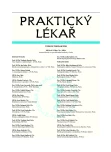Recombinant human erythropoietin treatment
Authors:
J. Slipac
Authors‘ workplace:
Předseda: doc. MUDr. Ivan Čundrle, CSc.
; Česká společnost bezkrevní medicíny, Brno
Published in:
Prakt. Lék. 2009; 89(10): 576-580
Category:
Of different specialties
Overview
Recombinant human erythropoietin (rHuEPO) is used in the treatment of various types of anaemia (eg. in patients with chronic renal insufficiency, anaemia in premature babies, anaemia in certain onco-hematological illnesses, chemotherapy-induced anaemia, anaemia in human immunodeficiency virus (HIV) infection, and to redress anaemia before surgery). Erythropoietin stimulates the production of red blood cells from the bone marrow, speeds up red cell maturation 3–4 times and increases the reticulocyte count within 3–4 days. RHuEPO can be effectively used in strategies to avoid blood transfusion. The response is improved by oral or intravenous iron. Erythropoietin has proven efficacy in addressing anaemia associated with a variety of conditions and, with or without iron, can be an alternative to red blood cells transfusion.
Key words:
bloodless medicine, anaemia, erythropoietin, iron.
Sources
1. Brejcha, M., Gumulec, J., Klodová, D. et al. Diagnostika a léčba anémie u onkologických pacientů. Doporučení pro klinickou praxi. Nový Jíčín: Onkologické centrum J. G. Mendela, 6/2006. Dostupné na http://www.onkologickecentrum.cz.
2. European Medicines Agency. European Public Assessment Reports (EPAR) for authorised medicinal products for human use [on line]. Dostupné na http://www.emea.europa.eu/htms/human/epar/a.htm.
3. Biogenerics pipeline. Erythropoietin [on line]. Dostupné na http://www.biogenericspipeline.com/ epo/epo.
4. Rudmann, S.V. Textbook of blood banking and transfusion medicine. Second Edition. Philadelphia: Elsevier Saunders, 2005, p. 376.
5. Slipac, J. Bezkrevní medicína. Praha: Triton 2008.
6. Spivak, J.L. The mechanism of action of erythropoietin. Int. J. Cell Cloning 1986, 4, p. 139-166.
7. Rinsch, C., Regulier, E., Deglon, N. et al. A gene therapy approach to regulated delivery of erythropoietin as a function of oxygen tension. Hum. Gene. Ther. 1997, 8(16), p. 1881–1889.
8. Svensson, E.C., Black, H.B., Dugger, D.L. et al. Long-term erythropoietin expression in rodents and non-human primates following intramuscular injection of a replication-defective adenoviral vector. Hum. Gene. Ther. 1997, 8(15), p. 1797-1806.
9. Salido, J.A., Marín, L.A., Gómez, L.A. et al. Preoperative hemoglobin levels and the need for transfusion after prosthetic hip and knee surgery: analysis of predictive factors. J. Bone Joint Surg. Am. 2002, 84-A(2), p. 216-220.
10. García-Erce. J.A., Solano, V.M., Cuenca, J., Ortega, P. Preoperative hemoglobin as the only predictive factor of transfusional needs in knee arthroplasty. Rev. Esp. Anestesiol. Reanim. 2002, 49(5), p. 254-260.
11. García-Erce, J.A., Cuenca, J., Solano VM. Predictive factors for transfusion requirements in patients over 65 years old with subcapital hip fracture. Med. Clin. (Barc) 2003, 120(5), p. 161-166.
12. Monk, T.G. Preoperative recombinant human erythropoietin in anemic surgical patients. Critical Care 2004, 8 (Suppl 2), p. S45-S48.
13. Gonzalez-Porras, J.R., Colado, E., Conde, M.P. et al. An individualized pre-operative blood saving protocol can increase pre-operative haemoglobin levels and reduce the need for transfusion in elective total hip or knee arthroplasty. Transfus. Med. 2009, 19(1), p. 35-42.
14. Ludwig, H., Van Belle, S., Barrett-Lee, P. et al. The European Cancer Anaemia Survey (ECAS): A large, multinational, prospective survey defining the prevalence, incidence, and treatment of anaemia in cancer patients. Eur. J. Cancer 2004, 40(15), p. 2293–2306.
15. Henry, D.H., Spivak, J.L. Erythropoietin and Oncology. In: Transfusion Medicine and Alternatives to Blood Transfusion, 2000 [on line]. Dostupné na http://www.nataonline.com/CONNATTex.php3.
16. Bennett-Guerrero, E., Veldman, T.H., Doctor, A. et al. Evolution of adverse changes in stored RBCs. Proc. Natl. Acad. Sci. USA 2007,104, p. 17063–17068.
17. Bokemeyer, C., Aapro, M.S., Courdi, A. et al. EORTC guidelines for the use of erythropoietic proteins in anaemic patients with cancer. Eur. J. Cancer 2004, 40(15), p. 2201-2216.
18. Bokemeyer, C., Aapro, M.S., Courdi, A. et al. EORTC guidelines for the use of erythropoietic proteins in anaemic patients with cancer: 2006 update. Eur. J. Cancer 2007, 43(2), p. 258-270.
19. Aapro, M.S., Link, H. September 2007 Update on EORTC guidelines and anemia management with erythropoiesis-stimulating agents. Oncologist 2008, 13( suppl. 3), p. 33-36.
20. Aapro, M., Scherhag, A., Burger, H.U. Effect of treatment with epoetin-beta on survival, tumour progression and thromboembolic events in patients with cancer: an updated meta-analysis of 12 randomised controlled studies including 2301 patients. Br. J. Cancer 2008, 99, p. 14-22.
21. Buemi, M., Caccamo, C., Nostro, L. et al. Brain and cancer: The protective role of erythropoetin. Med. Res. Rev. 2005, 25(2), p. 245-259.
Labels
General practitioner for children and adolescents General practitioner for adultsArticle was published in
General Practitioner

2009 Issue 10
- Memantine Eases Daily Life for Patients and Caregivers
- Metamizole vs. Tramadol in Postoperative Analgesia
- Metamizole at a Glance and in Practice – Effective Non-Opioid Analgesic for All Ages
- Memantine in Dementia Therapy – Current Findings and Possible Future Applications
- What Effect Can Be Expected from Limosilactobacillus reuteri in Mucositis and Peri-Implantitis?
Most read in this issue
- Recombinant human erythropoietin treatment
- A new clinical unit DSD – disorders of sexual development and their consequences
- Accreditation of general practitioners‘ surgeries in the Czech Republic
- Micrometastases in the sentinel lymph node – necessity of axillar lymph node dissection?
